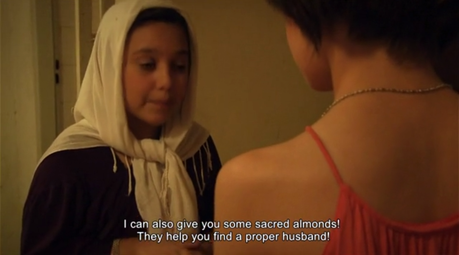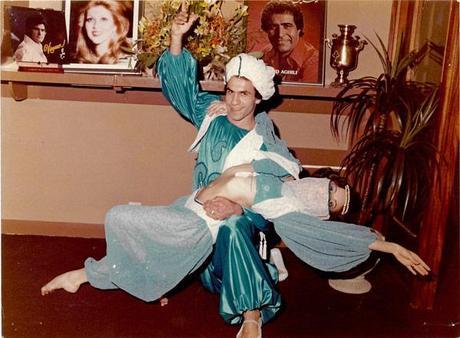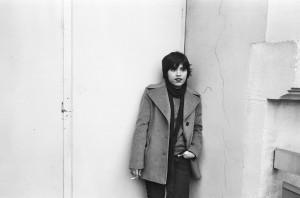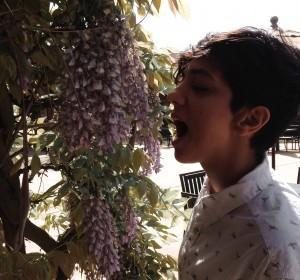When the Kid was a Kid, a film by Anahita Ghazvinizadeh, 2011, Iran, 17 min.
Gelare K. in conversation with Anahita G. about her film “When The Kid Was A Kid.”
Gelare Khoshgozaran: Where did the idea for the film come from?
Anahita Ghazvinizadeh: Let me first tell you briefly how I became a filmmaker and I got to the point that I made this film. I went to school at the University of Arts in Tehran. In school it was not mandatory or part of the curriculum to make films especially as a screenwriting major. I met my colleague, Morteza Farshbaf, in school. Later we both got into Kiarostami’s workshop and there I started making films. We made two short films together and co-wrote a feature. Later I signed up for some creative writing classes with Shadmehr Rastin[i]. When the Kid Was A Kid was the very first story that I wrote as class assignment. I don’t know if it was unconscious or it just came from intuition but it definitely didn’t come from any theory or theoretical thinking. Later I really got interested in studying children, children psychoanalysis and gender studies, but at that point that was not at all what I was reading. Sometimes I think, like any other work, it’s partly autobiographical. We sort of had this game of gender role-playing in my family because everyone was always questioning their gender roles and making fun of “womanhood” or “fatherhood”. As a kid I wasn’t really allowed to wear girly clothes and put make up on. I remember going to our friends’ houses and getting to their parents’ closet, wearing women’s clothes and feeling like I was in drag. We also used to play the games of playing our parents’ roles in the basement of my friend’s house so the story comes from those memories too. After getting feedback from my friends I just added more details to the story, then I started rehearsing with the actors. We were playing games for a couple of months. And the kids contributed a lot to the story from their real lives.
G: What did they think of the story?
A: My method was to rehearse with Taha, the main character, separately. He and the rest of the kids had not met each other. The other kids were really comfortable playing their parents’ roles. They loved the game and enjoyed every moment of it. As for Taha, I think he was very much enjoying it when he was rehearsing with me. But then there was a moment around the time of shooting when he was first meeting with the other kids that was a little rough. I think I did that intentionally because the whole story is about how he meets this group of children through this game. He has met them before but it is the first time that he enters their game. He had this quality of feeling reserved or isolated about him, which is also present in the film. I introduced him to the group a few days before the shoot. I could sense that he feared getting bullied or teased by the other kids, but that did not happen. Some people watching the film expected that there would be more strange reactions to his role-playing form the part of the other kids but I just knew that it should look very natural, as it was in the rehearsals and behind the scenes. I didn’t feel like he was annoyed by the other kids’ reactions. It was a very collaborative process and they became the makers of the film and felt very important. It was a joyful process for most of them despite the long hours of shoot in very few days.
G: I think one of the nice things about the story is exactly that there are no severe reactions to Taha’s cross-dressing. He’s just one of the players in this little game of performing gender and adulthood. It was interesting to notice the subtle tensions and attractions between her and Hossein Agha in the elevator scene before saying goodbye or at dinner when Hossein Agha was sitting next to her and flirting with her her. In fact the wonderful thing about the story is that, through this game, it depicts a world where everybody’s gender performance is a given, whether or not it is one’s biological gender.
A: There is a kind of contradiction even in the style of the film, which may be very realistic but there is nothing real about this whole setting and this game. It is really amazing how gender performance, cross-dressing or any gender nonconforming is so effortless for kids. The script that I’m writing for my feature film is also about trans children and children who are diagnosed with gender dysphoria or GID. I have been reading about how based on their performance they determine whether or not they were born with the wrong body and their gender is determined. This pre-adolescence period when children are more observing, rather than becoming or changing biologically especially within the family dynamics is something that I’m still working on and it comes from When the Kid Was A Kid.

Film Still, When the Kid Was A Kid
G: Especially in the social context where this film was made and where you and I both grew up, you are allowed to have that playfulness until a certain age. But soon you feel this desire to determine who you are based on the existing examples around you. You want to identify with others and be mirrored in order to be recognized as an adult or just to be seen as a person. Before that you have had this period of just messing around with your gender, which families and the society in general are usually very open to. In that sense there is something very romantic about the way that the film has been set up because it is so isolated from the adult world, and simultaneously an imitation and constant interpretation of it. I think this gives it a trivializing effect in the sense that it feels as if the camera is just observing and documenting a game that these kids are playing. In the absence of any interactions with adult bodies who are only indexed by their voices the film also has a unique sense of scale. It sets up a miniature world where everybody’s small; almost everyone’s clothes are too big for them but there is also no reference to the “right-sized” body.
A: This story and watching this film is about the way that they are invisible to adults. But there is also something more general about (in)visibility in regards to this age range. My more recent film, Needle, is about a girl who is getting her ears pierced. Her parents are having quarrels all the time and the family is very dysfunctional. There is this scene that just came out this way but I kept it as is. The girl walks into both men and women’s bathrooms as she is just wandering around in the hospital. It was something that was always brought up in the Q&As of the film. As I was trying to articulate it in different Q&As I realized there was something about the invisibility of children at this age and it is because of the certain way that they are, not being noticed as much as an adult would be who walks into the “wrong” gender specified space. I think where we come from, it might be in some ways stricter but there is a certain age when you can really experiment these things without being discouraged or reprimanded.
G: I remember my grandmother’s favorite moment at our family reunions was when I would put on drag, draw a mustache on my face, dress up as Jahel[ii] and do the Jaheli dance even up until when I was a teenager. I would put on the clothes: the shoes, white shirt, jacket and the fedora and throw the rag around my neck and do the dance in front of my big family. But there was always a time and age and certain contexts where that was allowed. Outside of that you had to present your gender a “proper” way. That’s why it was rather nostalgic to watch this film.
A: My family was not really educated in the field of gender. Perhaps the only thought that I had been influenced by was a very basic feminism that was supported in my family. I am very grateful that my parents were so stupidly playful about gender roles. My mom was always making a point that she was not a traditional mother and my dad was always making fun of fathers who were very determined and had a mustache and made decisions for the family. The whole thing about my mother being a housewife somehow became a parody of a housewife. So I think one of my main inspirations was this weird family life that I suffered from as a kid a lot because I was very embarrassed by my parents. When my mom showed up anywhere she was very different from any of my friends’ moms. Now when I look back I am very proud of it. Maybe I was wounded and I’m still wounded by it somewhere inside of me. But it had such a great impact on me to have a weird family.
G: A weird family is the great kind of family!
A: A good family is a family that fails.
G: Well, every family fails. Family is a failure but the good kind of family is the one, in my opinion that acknowledges its failure. I’m going to ask you a little typical journalistic question. Do you feel inspired by anything specific from the visual pop culture that you grew up with? Do you see any of that in your work?
A: Yes, for sure! My grandmother and the things she liked. She was very fond of sit-coms, popcorn, pizza, Coca-Cola and junk food, ironically better than all the Persian food that she cooked. She also loved all these Jaheli shows and dances among other things. But I think my first inspiration was Khordadian[iii].
G: He was a gem!
A: My grandmother really loved the flamboyant gay men in Persian pop culture like him or Jalal Hemmati, and of course, Jamileh[iv] and all her cross-dressing Jaheli dances. I also loved the movie Adam-Barfi [Snow(wo)man]. Akbar Abdi cross-dresses and plays a woman almost throughout the entire movie. I watched it at least twenty times at my grandmother’s house. As for television, one of the most inspiring TV shows for me and for millions of others kids and adults in Iran was Kolah Ghermezi. I totally think of the little puppets in the show as queer. The show was full of gender role-play in different forms. I loved the parts where Kolah Ghermezi put on make-up and a veil and impersonated a pregnant woman who was allergic to all kinds of food except chocolate! In a way Kolah-Ghermezi became an iconic gay figure for me; his emotional responses, his tone of talking, it was all very different from a typical “young boy”. He was the embodiment of a kind of gender non-conformity in young people. These are some examples of inspirations from mainstream Iranian television, not to mention the Persian pop music videos and Iranian Los Angeles televisions!

Mohammad Khordadian is an Iranian-American choreographer, dancer and entertainer.
G: I think that is very important to think about the dominant pop culture that we grew up with during a time of extreme scarcity as opposed to what there is today. There has been a generational shift but let’s also blame it on the global heterosexism! It is fascinating to see how during the 60’s and 70’s, drag (for both men and women) was one of the most popular elements of the entertainment culture; effeminate men were the most successful performers, comedians, musicians, etc. And since the 80’s there has been an increasing disidentification between the transgender and homosexuals in Iran because of the state support for transsexuality and the criminalization of homosexuality, hence an overall erasure of the image of gay, especially men. For example Fereydoun Farrokhzad[v] was one of the most popular and influential figures of his generation. Although most of those figures were very discreet about their sexuality and gender, even that ambiguity allowed them to perform in a unique way, people like Ramesh, Farrokhzad and even Hayedeh. Since the 80’s or 90’s we are more and more lacking that visual imagery. We grew up in a visual entertainment culture, produced mostly by the diaspora and almost accessible to everybody in Iran that was very queer aesthetically, to say the least.
A: I think there is also something about the Iranians in exile and the degree to which the exile culture has changed since the 70’s. I’ve been watching Shahs of Sunset and Befarmaeid Sham[vi] as part of my research. The way that Shahs of Sunset describes Iran is very exclusive to a certain class, whereas Befarmaeid Sham is much more diverse in that sense. There has been a new episode in Toronto, for example with participants who have just immigrated; whereas the Shah of Sunset is about the people who left Iran in the 70’s and 80’s and their Irans are so different. I just sit down and watch them and write down notes in a document I have named “Varieties of Exile” that is also the name of a book by Mavis Gallant. There’s something about the exile culture of the 80’s to the 90’s, the first decade of Iranian immigrants in exile trying to maintain an identity that was different from what was going on in Iran.
G: It’s interesting you brought up Shahs of Sunset. That is a very good example because one of the main characters on the show is a gay man, Reza. Thinking of that gayness as opposed to Farrokhzad is an interesting comparison to me. To me Reza is “gay” whereas Farrokhzad or Khordadian were “ivakhahar”[vii]. If we think of these two as examples of Iranian “gayness” in the media, Shahs of Sunset is fulfilling a checklist that requires them to have a gay character perhaps for the sake of political correctness. But the way that a popular figure like Farrokhzad performed his gender was completely fascinating or the influences of Khordadian as the first Iranian male dance teacher and choreographer in diaspora. It all has to do with the establishment and shaping of an exile culture, as you said, that is so young and new. I’m trying to avoid the word “authentic” but I would say a culture that was not trying to be anything other than itself, at least not trying to be the “Iranian counterpart of any American thing”. We can keep talking about this forever but are you currently working on something you want to talk about?
A: I’m really glad to talk about When the Kid Was A Kid. It’s not very worthy of discussion when it comes to festivals. I hate them at this point. But there’s something interesting about my experience with this film that was rejected form almost everywhere. I showed it in smaller ones—in the stupid hierarchy of festivals—in Europe, but not in the major ones. After I made Needle and it got accepted in more well known festivals, people came back to watch When The Kid Was A Kid on my vimeo channel. There are a lot of people who say they like this one or that one better. The comparison is not very constructive for me. But it’s interesting that the film that was not really seen much at the time it was made, people later returned to it and said it was even better than my new work. That was an interesting journey that I had. And now it’s doing well and I’m showing it in different places especially because it is more related to the work that I’m going to make as my first feature film.
G: So are you working on your feature now?
A: I’m writing the script now. It’s about a young character that is gender ambiguous and it’s about siblings’ relationship in the absence of the parents where the older sibling takes care of the younger one, my main character. So I am kind of recasting the family in different forms through these sibling relationships, the gender roles, power relations, different forms of relationships in the family that are being examined during the few days that the siblings are together. That’s the story I’m working on now but it was very much inspired by When The Kid Was A Kid.
________________________________________________________________________________
Footnotes:
[i] Iranian documentary filmmaker and screenwriter
[ii] Jâheli or Baba-Karam is a type of 20th century Iranian dance that the “Jahel”--middle class tough guy types often accompanied by their entourage of fellow Jâhels--did on the streets of Tehran.
[iii] Iranian American dancer, choreographer and entertainer also the first Iranian male dancer to publicly come out as a homosexual during a TV interview in 2006. See: http://www.bidoun.org/magazine/24-sports/keeping-up-with-the-khordadian-the-life-and-times-of-the-king-of-iranian-dance-by-negar-azimi/
[iv] Iranian belly dancer, choreographer and entertainer, known as the Goddess of Persian Dance, who was the first woman to do the Baba Karam dance dressed in men’s (Jaheli) clothes.
[v] Legendary Iranian singer, actor, poet, TV and radio host, writer, opposition political figure, and the brother of the acclaimed Persian poet and filmmaker, Forough Farrokhzad.
[vi] Befarmaied Sham (Help Yourself to Dinner!) is a popular Iranian reality TV cooking competition produced by Manoto TV.
[vii] Persian term for ‘gay man’ literally meaning Oh, sister!
________________________________________________________________________________
ARTIST BIOS
 Anahita Ghazvinizadeh (b1989, Tehran, Iran) got her BFA in cinema from Tehran University of Art and her MFA in studio arts from The School of the Art Institute of Chicago. Anahita has studied with Abbas Kiarostami and is influenced by his cinematic style. Since 2011 she started to work on a trilogy of short films with children as main characters. When the Kid was a Kid (2011, Iran) and Needle (2013, US) are the first two finished pieces. Needle was premiered in Cannes Film Festival, Cinefondation selection and won the Premier Prix. Anahita was selected as one of the 25 New Faces of Independent Cinema in 2013 by the Filmmaker Magazine. She is also the co-writer of the acclaimed feature film, Mourning (2011). Childhood and parenthood, family theater, and exploring notions of growth and gender identity are the main themes of her work.
Anahita Ghazvinizadeh (b1989, Tehran, Iran) got her BFA in cinema from Tehran University of Art and her MFA in studio arts from The School of the Art Institute of Chicago. Anahita has studied with Abbas Kiarostami and is influenced by his cinematic style. Since 2011 she started to work on a trilogy of short films with children as main characters. When the Kid was a Kid (2011, Iran) and Needle (2013, US) are the first two finished pieces. Needle was premiered in Cannes Film Festival, Cinefondation selection and won the Premier Prix. Anahita was selected as one of the 25 New Faces of Independent Cinema in 2013 by the Filmmaker Magazine. She is also the co-writer of the acclaimed feature film, Mourning (2011). Childhood and parenthood, family theater, and exploring notions of growth and gender identity are the main themes of her work.
 Gelare Khoshgozaran (born 1986, Tehran, Iran) is an artist, a translator and an independent scholar living in Los Angeles, CA. She has contributed to multiple Persian and English publications and websites including Parkett, The Enemy Reader, WildGender and ZanNegaar Journal of Women Studies. She is the translator of Critical Theory: A Very Short Introduction to Persian (Ofogh Publishers, Tehran, 2014). Gelare received her MFA from the University of Southern California and her BA in Photography from the University of Arts, Tehran.
Gelare Khoshgozaran (born 1986, Tehran, Iran) is an artist, a translator and an independent scholar living in Los Angeles, CA. She has contributed to multiple Persian and English publications and websites including Parkett, The Enemy Reader, WildGender and ZanNegaar Journal of Women Studies. She is the translator of Critical Theory: A Very Short Introduction to Persian (Ofogh Publishers, Tehran, 2014). Gelare received her MFA from the University of Southern California and her BA in Photography from the University of Arts, Tehran.
